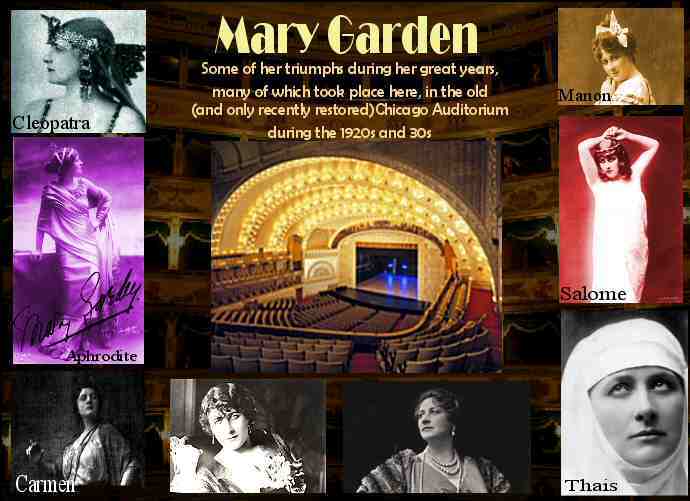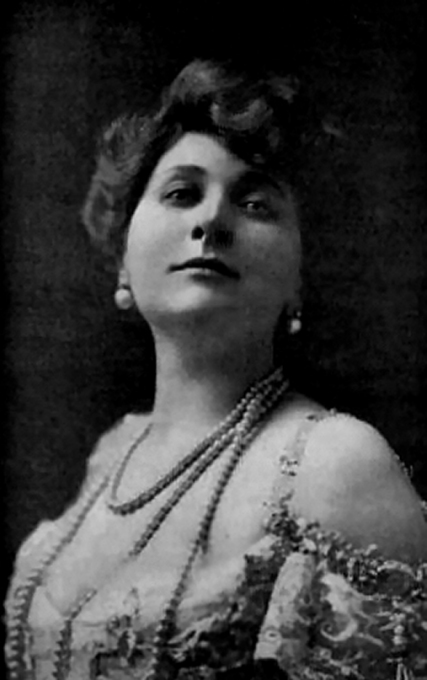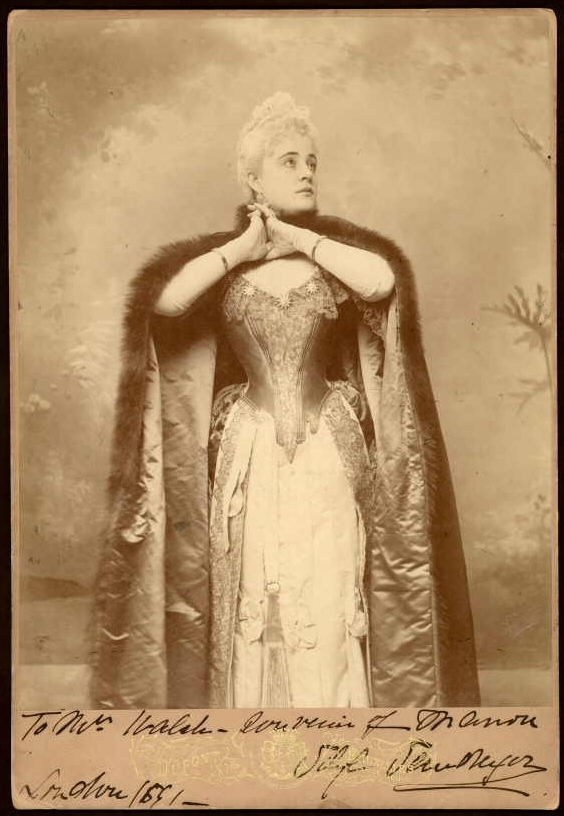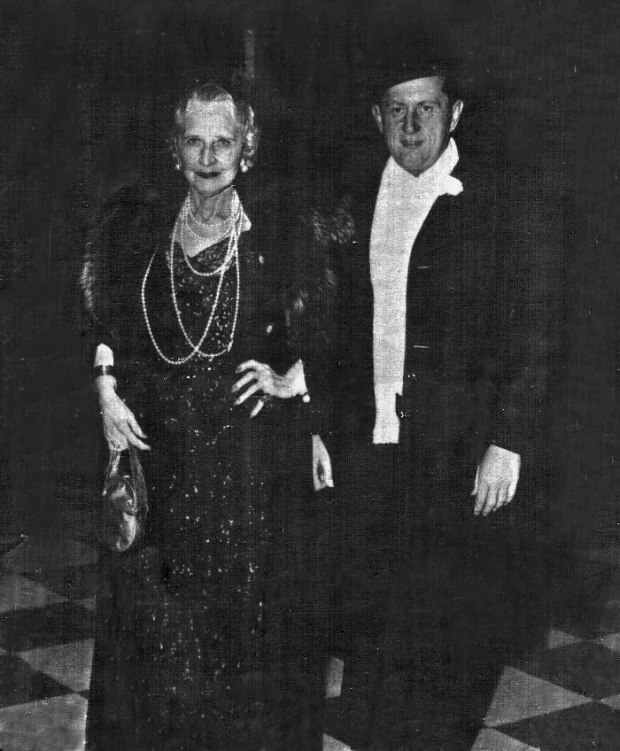MARY GARDEN OPERA SINGER
PAGE TWO
(Jim Brooks)
Hi Haytoner, I'm very glad that Mary Garden's magic is still potent and that you find her intriguing. I don't mean to be patronising towards fellow Aberdonians, but I what I can't
get over is the fact that a lassie from Charlotte Street, entirely through her own determination made herself such a huge star and got to the top in what was still very much a man's
world.
I never thought of trying YouTube, a great way to hear singers which I've used mainly for rare material on Kay Starr, Julie London, Peggy Lee, Ella Fitzgerald and other favourite
girl singers.
I can see - or rather hear - what you mean about "Annie Laurie". It IS a refined sound for a traditional song, but throughout her career she seemed to have a fondness for Scots
song, and also recorded "Jock o' Hazledean", "John Anderson, my Jo", "Comin' through the rye", "Afton water" - and even "The Bluebells of Scotland". She often said she hated
her most of her recordings with the exception of "At dawning" so it's good that her favourite ison YouTube.
One of the things I like about her Scots songs is the strong personailty and humour that comes across in them, and "Annie Laurie", being a later and better quality recording does
show in its long lines, that even in her mid-fifties Mary Garden could still produce a beautiful, even sound.
You're right about the autobiography. Though the basic facts are OK, if her version is more interesting and colourful than the truth, she'll cheerfully rewrite history! I reckon the
book's great value and its importance lie in the fact that it gives a good sense of her powerful personality, not to mention an outsize ego! For the facts, Michael Turnbull's book is
terrific for the amount of material he has unearthed.
Here's another wee pic of those famous pearls...
"I started at the top, I stayed at the top and I left at the top" (Mary Garden)
(Jim Brooks)
I had fun putting this together. Maybe it'll jog a few local memories?
Here’s more of Quaintance Easton’s view of Garden in her book “The Boston Opera Company" (1965), describing how the Aberdeen lassie transformed herself into an exotic
opera star – and did in what was still very much a man’s world:
In Boston Garden attracted controversy and audiences in equal measure, as she had always done. Henry Russell, his first impressions of about a singer’s prospects generally infallible,
mistook Mary completely. She had been an early pupil of his in London in the days when the quiet Scottish mouse had grown no protective armour. She would never make the grade
in grand opera, he predicted. At twenty, her shyness, her wistful docility, her devotion to family and country showed her to be a sweet lass, nothing more. The ineffable showmanship
appeared only after the piercing lights of notoriety had shone upon her, mixed with the beams of fame and achievement. She told Mrs Russell that the moment before she had to sing
“Depuis le jour” for the first time, she turned her back on the audience and whispered to herself; “Now or never!” It was now. From the moment of her debut, the private Mary seemed
to disappear; the legend blossomed. Mary Garden’s legend runs in many channels, flashing many-coloured glints from its shallow surfaces, glittering under arc lights, as various as its
observers. The public Mary could utter no word that was not reproduced in headlines within hours; by the same token, words she never said clung to her by attribution, adding to the
legend. In turn she appeared great lady, shrew, gamine, supreme artist, girlish prattler, femme fatale. The ”real” Mary that hid behind these phrases had been born of bitterness,
disillusionment, deep resentment and humiliation. Love spelled frustration; friendship meant too much taking, too much giving.
To an associate and admirer, the pianist George Copeland, she appeared as a grande dame, with a flow of conversation that commanded a whole dinner table, and an unfailing courtesy
to her host; never did she dine but the next morning five dozen red roses appeared with her card of thanks. The slim figure that never varied an inch from year to year owed its felicities
to a diet that also never varied, even when she was in her seventies – a thin soup, grilled fish or meat, one vegetable, and two glasses of champagne with fruit. She could wear a dress
that showed her back to be perfect, like a girl’s. “I feel right this way; why should I spoil it!”.(Haytoner)
Hi Jim, I hope you don’t mind answering some questions I have concerning the lifeof Mary Garden. First of all, regarding her early life in Aberdeen;
1. I know the family were living at 35 Charlotte Street at the time but where was she actually born?
2. Do you know when exactly the family moved to 41 Dee Street?
3. It is inferred from the Turnbull book that she moved to USA in 1883, do you concur with this?
4. Mary would have been 9 years old at the time and so would have been attending school for 4 years or so. Do you know which Primary School she attended? My guess would be
Skene Square but as far as I know it has never claimed her as one of its FPs.
5. She attended St. Margaret’s School in Albyn Place for a year when the family returned to Aberdeen in 1889. Do you know if the school have any acknowledgment of this?
It seems to me that Sibyl Sanderson for, to the extent that she was virtually destitute when Sibyl took her under her wing. In the book I am reading it seems that when she found initial success
Mary was less than gracious in her treatment of Sibyl, refusing all Sybil’s pleas for help when the roles were reversed. Perhaps she did not want to give her money because she knew that
Sybil was an alcoholic, but she did seem to be rather unkind to her up until Sybil died. In her autobiography, which I know you have a copy of, how does Mary explain her actions, if at all?
Sorry to sound so cold and formal with these questions, but is the easiest way to get things clarified, hopefully we can have a more informal chat about it sometimes and I believe you have
attended one of the Papa Mojo gigs, so perhaps I will see you at a future one.
P.S. I have only just commenced reading the Turnbull book seriously and am currently at the year 1909. I find the book fascinating.(Jim Brooks)
Always more than happy to discuss Mary any time, Haytoner. I had always assumed that Mary was born at home, 35 Charlotte Street, in the absence of anything saying she was born in a
hospital. She was born on 20 February 1874, just a month after the marriage of her parents, but later she would claim that she was born in 1877, ”legalising” things and of course
conveniently knocking three years off her age!
Sisters Amy and Agnes were born in 1875 and 1877, so I suppose the family moved to 41 Dee Street some time after that. I have never seen the actual date recorded - Mary was very
successful at obscuring her true origins. I’m afraid I have no idea which primary school Mary attended. I think Dee Street would have been in the area for Ferryhill (my old primary school),
but the school buildings don’t look old enough to have been around in the 1880. Perhaps someone knows if it was rebuilt?
I recently had some involvement with Lisa Milne and a BBC producer who were working on a 30 minute programme which will discuss and contrast Mary’s life in Aberdeen and her career
with Lisa’s experiences 100 years later. I’m sure they contacted St Margaret’s School, but there was no information other than the basic records, but look out for the programme on Radio
Scotland some time in October. You never know!
Sybil Sanderson took Mary under her wing just at the lowest point in Mary’s life, just when she found herself penniless in Paris. She took Mary into her home and introduced her to all the
right people, including the composer Massenet and the manager of the Opera Comique where she eventually made her debut. I suspect she was also the major influence on Mary’s
approach to opera. Both were beautiful and accomplished actresses as well as singers, and both knew how to hold the stage. It was alleged that at one Sanderson performance when a
crucial shoulder strap broke, exposing her breast, it might not have been the accident she claimed. It never happened again, but of course there wasn’t a seat to be had for the remainder of
the performances! That sort of publicity seeking was something that would become second nature to Mary.
Mary did acknowledge her gratitude to Sanderson and I believe that her slow, painful death affected Mary as deeply as anything in her life, but I have to acknowledge that the reasons Mary
gave for her refusal to help Sanderson financially don’t quite convince – that any money she gave her would simply have gone on alcohol and drugs. There would have been other ways to help.
I agree that Turnbull’s book is fascinating. Rightly, it’s unsentimental and clear-eyed, but so much of Mary comes through in her wildly inaccurate autobiography that it’s required reading too.
Copes do turn up in the charity bookshops (Oxfam and Barnardo’s) from time to time, but the last one I saw, for just £2.50, was at the annual Queen Cross church book sale, which was a
couple of months ago. Wish I’d picked it up for a spare to pass on to someone like you!Thought I might flesh out Mary Garden's later years with this undated picture, which I imagine would be on one of her US lecture tours in the early or mid 1950s. She'd have been well into her
seventies and still a handsome woman - but not someone I'd have cared to cross!
(Haytoner)
Hi Jim, Thanks for the reply. I think that around 1874 a high percentage of births were at the family home so you are probably right in thinking that she was born in Charlotte Street. The reason I was
curious to know when they moved to Dee Street was in order to try to establish which Primary School she went to, or if she attended two of them. I don't think Ferryhill was around 1880c, (pity,
because as an F.P. you may have sat at the same desk; well maybe the same classroom) but I think Skene Square could have been; anyway, I will find this out when I go to the library on Saturday.
I am now in the satisfying position of occasionally nodding my head in agreement as I read your posts about her. Please keep them coming as this is an excellent introduction to her for people who
know virtually nothing about her.(Jim Brooks)
Yes, I like the pictures in the Music Hall Tea Room; suitably glamourous, giving a good idea of Garden's charisma. I just feel that renaming the tearoom and that the rather sad little garden in Craigie
Loanings aren't enough. They don't motivate people to find out more about her.
I do understand that her career was made mainly abroad, but I wonder if achievements in the arts are not as readily recognised as they are in the sciences simply because they're harder to define.
After all, Garden's not the only one in that position. Dancer Michael Clark, Evelyn Glennie, who has been honoured as a Dame of the BRITISH Empire, Annie Lennox, fashioner designer Bill Gibb....
It's good to see that Lisa Milne has been better recognised with an honorary Doctorate from Aberdeen University, but I don't think she has had any recognition from the city. I reckon she deserves some
acknowledgement, not just for her musical achievements, which include starring at the Metropolitan Opera in New York. She has also done innumerable concerts for local charities - as well as singing
with Carreras in Edinburgh for one.
Why do you think we do so little to honour our own?(LogieExileLoon)
I remember hearing about and listening to her music on radio but knew little about her. I have also passed the house with the plaque on it numerous times. Therefore I am finding the comments and
additions on this Thread very interesting.
I apologise if it's been mentioned previously but I haven't seen it, there is an interesting section about her on Wikipedia, which includes other links. As Wikipedia is an 'open' source, perhaps one or all
of you could add more information to this web page.
Mary garden (Wikipedia)




